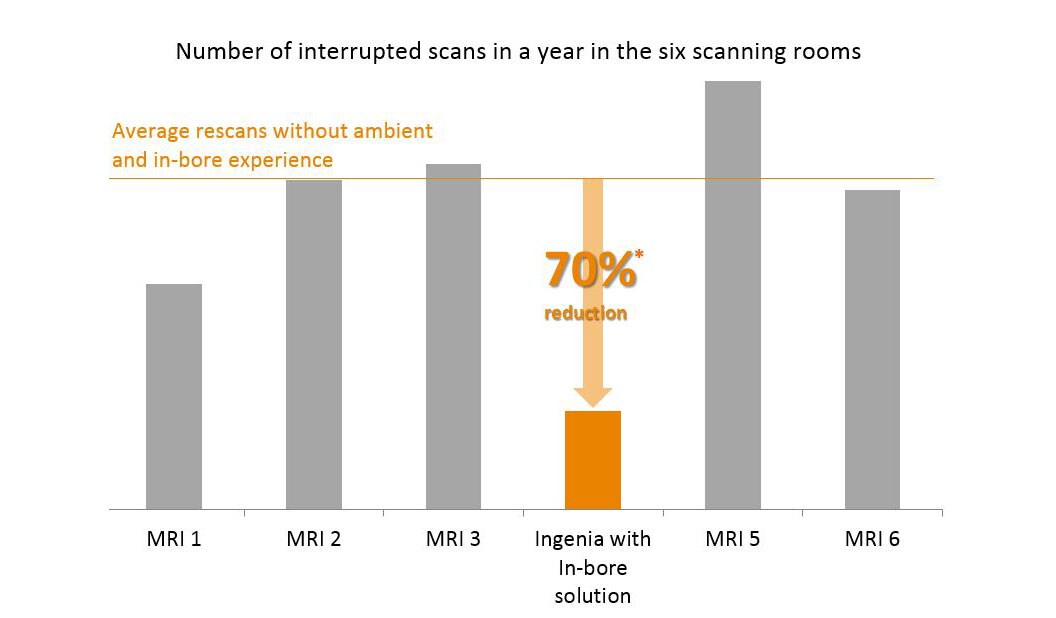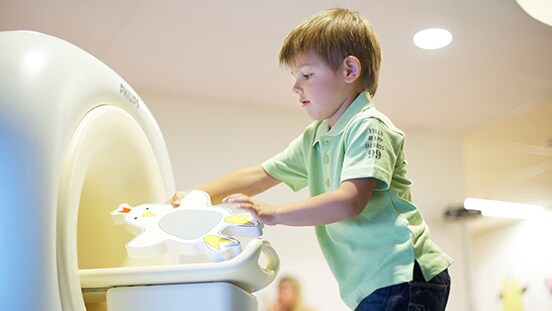FieldStrength MRI magazine
Educational - June 2016
Can improving MRI patient experience help to reduce motion artifacts and repeated sequences and thus have a financial benefit?
MRI motion artifacts are calculated to lead to revenue loss for the healthcare provider. As more relaxed patients are less likely to move during an MRI scan, can improving the MRI experience help to reduce motion artifacts?
Adopting a holistic approach, aiming to improve the whole trajectory of the patient’s MRI experience, may be key to improving patient satisfaction. It may also reduce motion and thus have a financial benefit.
“If our patients are happier at the start, they are less likely to move”
Jalal Andre, MD

Jalal B. Andre, MD
Jalal B. Andre, MD, DABR®, is Director of neurological MRI and MRI safety officer at Harborview Medical Center, Seattle, Washington, USA, and Assistant Professor of Radiology at the University of Washington School of Medicine, Washington, USA. He has several areas of expertise, including the clinical application of advanced MRI techniques in assessing brain vessel abnormalities and traumatic brain injuries.

Katarina Johansson
Katarina Johansson, is Radiology Nurse at the Astrid Lindgren Children’s Hospital, Stockholm, Sweden. She has particular expertise in the application of MRI for pediatric patients.
Anxious patients are more likely to move
Undergoing an MRI examination can be an intimidating experience for patients, causing feelings of fear and anxiety, and creating a sense of reduced self-control. [1] Anxiety reactions, including increased heart rate and blood pressure, have been reported in up to 30% of patients undergoing MRI scans. [2]
Specifically, entering the bore of an MRI scanner can be associated with anxiety reactions, with patients reporting feelings of abandonment or disorientation. [2] This emotional discomfort can increase the likelihood that a patient will move while in the scanner bore, resulting in motion artifacts which may blur image interpretation or even lead to retakes or aborted exams. [3]
Lost revenue due to patient motion leading to repeat scans
“We investigated the prevalence of patient motion in MRI about two years ago to try and quantify how often motion is occurring and when it’s occurring,” says Jalal B. Andre, MD, DABR, Assistant Professor of Radiology at the University of Washington School of Medicine. The study involved a retrospective review of scans conducted at a single institution, using three different MRI scanners, during a period of one week. [4] “Our study identified significant motion artifacts in almost 7.5% of outpatient MRI scans and nearly 30% of MRI scans performed in the inpatient and/or emergency department settings.”
In Dr. Andre’s study, motion artifacts were identified as the cause of repeated sequences in about 20% of MRI exams. Recent institutional data were used to compute a cost estimate, which was correlated with sequence time and severity of motion artifacts. “We calculated the financial consequence of repeat sequences due to motion artifacts to be about 115,000 US dollars of lost potential revenue per scanner per year.” [4]
Moreover, the repeated sequences can also create a cascade effect, resulting in increasing delays throughout the day and decreased patient throughput. “In addition, reducing or avoiding motion artifacts in MRI images can result in improved diagnostic confidence for the radiologists interpreting these studies, and aid them in formulating their diagnoses,” says Dr. Andre.

“We calculated that motion artifacts could lead to about 115,000 US dollars of lost potential revenue per scanner per year” [4]
A holistic approach can enhance the MRI experience
“I think it’s going to become more obvious as time goes on, that the MRI environment is fairly foreign to many patients, and that some factors related to the patient’s experience are important to identify in treating the patient as a human being. Ultimately, we want to mitigate the motion associated with these factors,” says Dr. Andre.
It is not just lying in the MRI scanner, or even being in the scanner room, that influences the MRI patient’s experience. Also preparation for the scan, scheduling the appointment, the stay in the waiting room and other factors contribute to it. This is why adopting a holistic approach toward making patients as comfortable as possible during their total MRI experience may be key to mitigating patient motion and its potential consequences.
According to Dr. Andre, undergoing an MRI exam as a patient can provide valuable lessons for a radiologist. “I was recently in an emergency and experienced having to undergo an MRI exam as a patient. Although I’ve previously undergone several MRIs as a volunteer subject, I had never been subjected to one while in acute pain. That was a very different experience and it really affected me. I imagine that the higher a pain score a patient reports prior to MRI, the more likely she/he is to move during the exam.”
“Changes have been made to the room and the lighting”
Design the environment to enhance the MRI experience
During the past decade there has been considerable attention on the in-room experience of patients undergoing MRI scans. As Dr. Andre says, “Changes have been made to the room and the lighting, intended to make people feel comfortable – just creating an overall ambience within the room that attempts to invite and relax the patient. I think the overall feeling is that everyone is aware of the need to comfort patients and they are trying to make improvements.”
“Using such approaches to comfort patients and help them relax can have a positive effect on the patient experience,” explains Dr. Andre. “At RSNA 2015 I saw a fantastic implementation of the system that Philips is using aimed at making the patient comfortable while in the bore: placing a monitor at the back side of the scanner, and using a mirror to redirect the image to the patient’s eyes. So the patient can watch what’s on the screen while lying in the scanner. I think that can be very helpful.”
“An engaging environment is particularly important for pediatric patients undergoing MRI scans,” says Mrs. Katarina Johansson, a Radiology Nurse at the Astrid Lindgren Children’s Hospital, Stockholm, Sweden. “We have dynamic lighting, projection and sound switched on as the child walks into the room. The light is very relaxing. Older children often tell us, ‘This is awesome, it’s not like I thought it would be’. When the children walk into the room with this really nice atmosphere, you easily win their confidence.”
Herlev Gentofte University Hospital (Denmark) designed their scanner environment and implemented Ambient and audiovisual in-bore experience to improve their patients’ MRI experience. Their efforts helped them reduce patient motion and increase efficiency. [5] In a recent case study at Herlev hospital they reported 70% reduction in rescans with MR Ambient and in-bore experience.*

Courtesy of Herlev Hospital, Denmark *Compared to the average of the other 5 MR scanners without Ambient and in-bore experience. Results from case studies are not predictive of results in other cases. Results in other cases may vary
"Using such approaches to comfort patients and help them relax can have a positive effect on the patient experience”
Transforming the in-bore MRI experience
Many methods have been explored and implemented to alleviate the MRI experience in the bore – for the sake of the patient as well as for reducing motion artifacts and retakes, benefitting department efficiency and the diagnostic confidence of the radiologist interpreting the images.
During an MRI scan, when being alone in the bore, a patient needs to lye still throughout the exam. An exam can often take 30 minutes or more. At the same time, the MRI exam can be associated with loud noises, and often the patient is additionally asked to hold their breath for some time.

An MR vendor can design the MR system, coils and accessories to enhance patient comfort during the exam. For distraction the patient can be allowed to listen to music or even undergo an audiovisual experience with an in-bore solution that provides visuals and sound.
Scan methods to mitigate or decrease the noise of the scan are available. Quieter technologies can attenuate the noise levels that many patients find distressing while undergoing MRI scans.
Countering motion with scan techniques
For many patients, and especially children and elderly, holding their breath during an MRI scan can be problematic. This can be made easier by speeding up scans to make breath-holding times shorter, or by developing scan sequences that are compatible with free breathing “There are available techniques like navigator echoes that can mitigate breathing motion. Depending on who you ask and how efficient the navigator is, it can have a relative effect on image quality,” says Dr. Andre.
“Prospective optical tracking systems are also in use to correct for motion. [6] I think these systems will have an added bonus in the long run because people don’t want to be strapped in; they want to be free to move a little bit and let the motion tracking system do the rest.”
Robust motion reduction methods based on data collection in concentric vanes are available to reduce motion artifacts in images when motion did occur during the scan.
“We try to make it a fun experience for the children”
Playful preparation for pediatric patients
There are indications that careful patient preparation may help reduce patient anxiety. Using a DVD with information to prepare patients for MRI scans [7,8] was shown to help patients feel less anxious during the scan and significantly reduce motion artifacts.
Many pediatric patients undergoing MRI require general anesthesia due to difficulties in remaining still for the length of the procedure. [9] The use of technology, such as audiovisual interventions, to distract pediatric patients has been shown to significantly reduce the need for sedation, and its associated risks to the patient. [9,10]
“Simply visiting a hospital can be an almost overwhelming experience for children, and especially for younger children who need to undergo a procedure without a parent present,” says Mrs. Johansson. “Ensuring a positive experience for children undergoing MRI scans brings its own particular set of challenges. Careful preparation is crucially important. If it is the first time a child is to be scanned, we ask them to come maybe one week earlier, just to say hello to us and to see the MRI scanner.”
The Astrid Lindgren Children’s hospital uses a play-scale model of an MRI scanner (KittenScanner) to help children become familiarized with the scanning procedure using toy characters.

“We use an MRI room design that was developed to reduce patient anxiety. Our patients choose an Ambient Experience theme that fits the age of the child,” says Mrs. Johansson. “The child enters a room that is not much like a hospital, but has round corners and the theme’s nice atmosphere. The child then tries to lie on the MRI table and go into the bore. I explain to them that they will listen to music and will meet their favorite character from the KittenScanner when they return. We try to make it a fun experience for the children instead of a scary one.”
Long exam window more likely to satisfy patients
Delays due to repeat scans, and interruptions due to emergencies, can negatively impact the patient’s experience prior to the MRI scan itself. According to Dr. Andre, reducing patient frustration caused by delays can have real benefits.
“For example, if a patient – who needs a 45-minute scan – is given a two-hour window instead of a fixed time, that buys us a little time in case an emergency comes up. That’s one way of establishing expectations early on for the patient. If the patient perceives that we are respecting their time, then they are more likely to be satisfied. If our patients are happier at the start, they are less likely to move. I think just making some changes to the way we are scheduling could help mitigate motion to some extent.”
“I imagine that patients feel that – regardless of what we attempt to do – scans are currently far too long in duration, and certainly longer than they expected,” says Dr. Andre.

Does the Affordable Care Act drive improvements?
“We send out patient surveys, while other surveys are done on-site to collect data on how satisfied our patients are. It reminds everybody how important it is that the patient is having a positive experience in the hospital, and helps define exactly what that experience is. If it helps us identify some simple changes that we can implement to make the experience better for people, I think that is a valuable goal.”
Patient satisfaction is increasingly being viewed as a major indicator of the quality of healthcare. [11] When the Affordable Care Act took effect in the USA, changes in reimbursement were introduced whereby some part of payment to hospitals is linked to patient satisfaction scores. [12] A key motivation behind this was the desire to improve the quality of care by gaining feedback from patients
“We hold monthly meetings in which we discuss patient satisfaction scores associated with their MRI scan,” says Dr. Andre. “Overall I think that patients report that they are relatively satisfied with their experience. Our monthly meetings have already been going on for years, so that aspect of the Affordable Care Act has had probably no effect at all on our practice. Luckily we have involved colleagues who foresaw this trend many years ago.”
Besides feeding back satisfaction scores to institutions and payers, patients’ perspectives are easily disseminated to their peers via social media. The views of satisfied patients can lead to increases in referrals, while negative experiences may result in loss of patients and revenue.
“If our patients are happier at the start, they are less likely to move”
References
1. Carlsson S, Carlsson E. 'The situation and the uncertainty about the coming result scared me but interaction with the radiographers helped me through': a qualitative study on patients' experiences of magnetic resonance imaging examinations. J Clin Nurs. 2013;22:3225-34. 2. Grey SJ, Price G, Mathews A. Reduction of anxiety during MR imaging: a controlled trial. Magn Reson Imaging. 2000;18:351-55. 3. Tornqvist E, Mansson A, Larsson EM, Hallstrom I. Impact of extended written information on patient anxiety and image motion artifacts during magnetic resonance imaging. Acta Radiol. 2006;5:474-80. 4. Andre JB, Bresnahan BW, Mossa-Basha M, et al. Toward Quantifying the Prevalence, Severity, and Cost Associated With Patient Motion During Clinical MR Examinations. J Am Coll Radiol. 2015;12:689-95. 5. Patient comfort leads to first-time-right imaging. Philips FieldStrength. 2015;2:6-9. 6. Herbst M, Maclaren J, Lovell-Smith C, et al. Reproduction of motion artifacts for performance analysis of prospective motion correction in MRI. 2014. Magn Reson Med; 71: 182-190.
7. Powell R, Ahmad M, Gilbert FJ, Brian D, Johnston M. Improving magnetic resonance imaging (MRI) examinations: Development and evaluation of an intervention to reduce movement in scanners and facilitate scan completion. Br J Health Psychol. 2015;20:449-65. 8. Science Daily. Instructional DVD reduces MRI scan patients' anxiety and improves scan quality. 9. Durand DJ, Young M, Nagy P, Tekes A, Huisman TA. Mandatory Child Life Consultation and Its Impact on Pediatric MRI Workflow in an Academic Medical Center. J Am Coll Radiol. 2015;12:594-8. 10. Harned RK 2nd, Strain JD. MRI-compatible audio/visual system: impact on pediatric sedation. Pediatr Radiol. 2001 Apr;31(4):247-50. 11. Morris BJ, Jahangir AA, Sethi MK. Patient Satisfaction: An Emerging Health Policy Issue. American Academy of Orthopedic Surgeons. 2013. 12. How the Affordable Care Act Affects Radiology. Diagnostic Imaging 2012.

